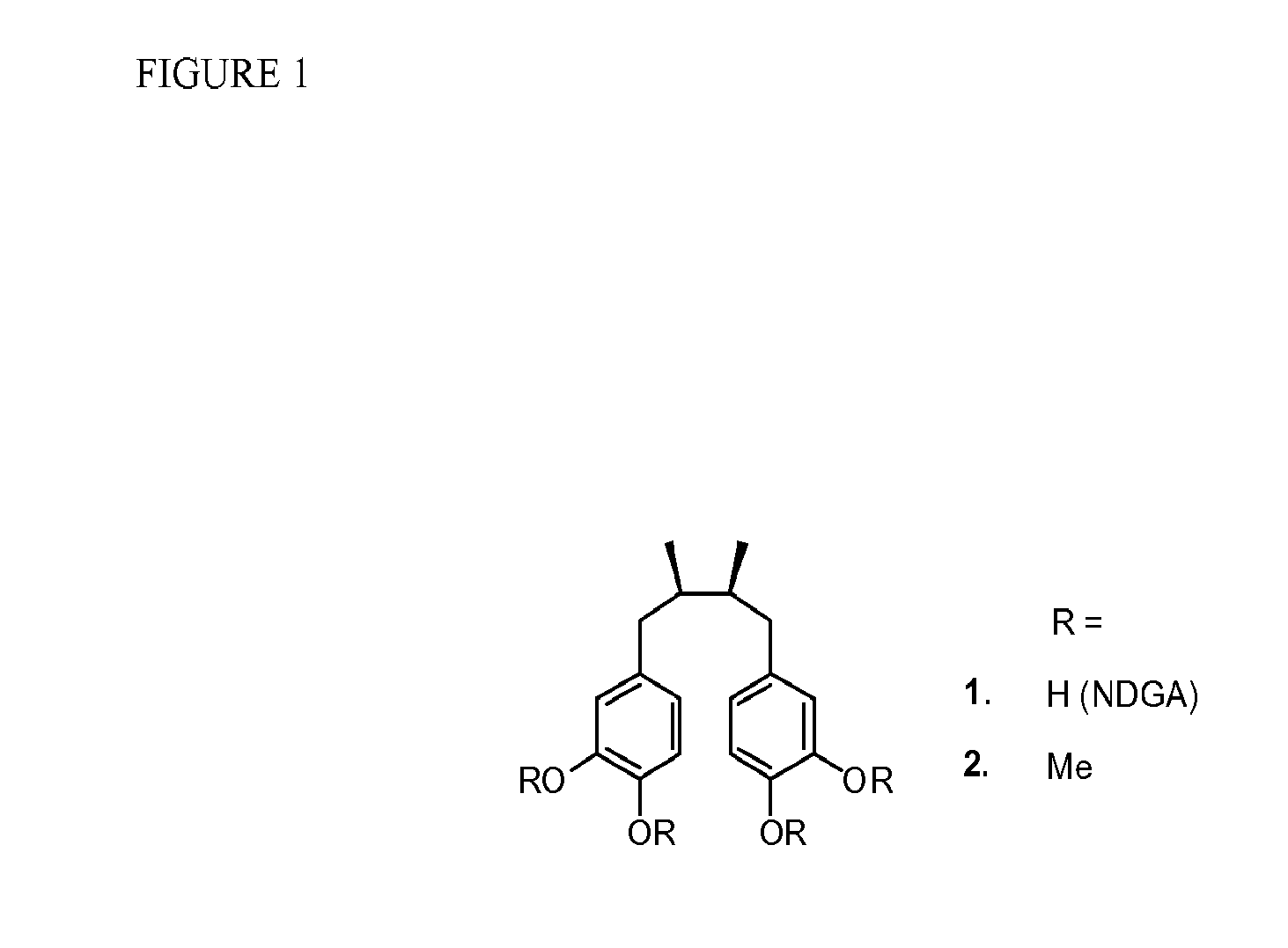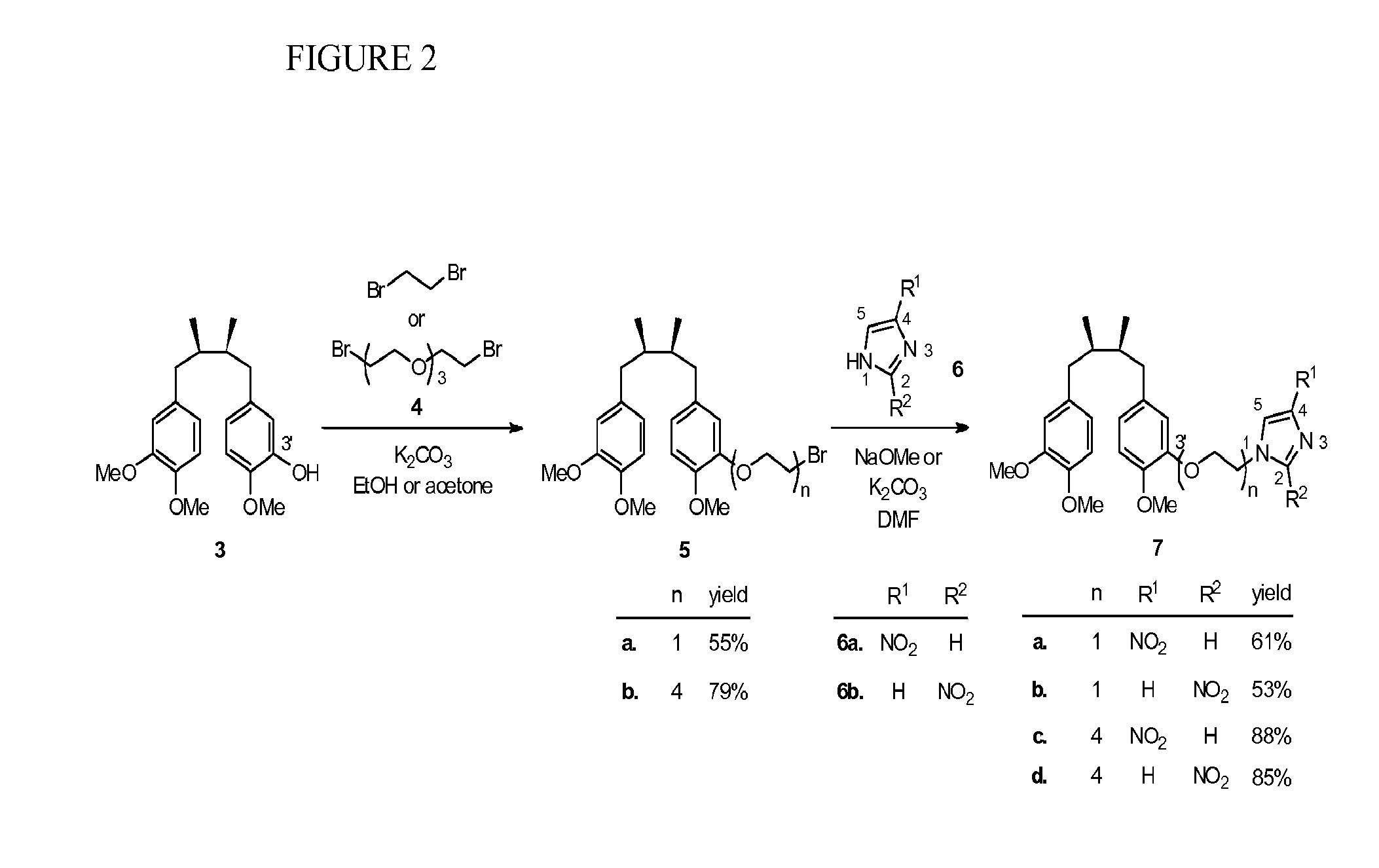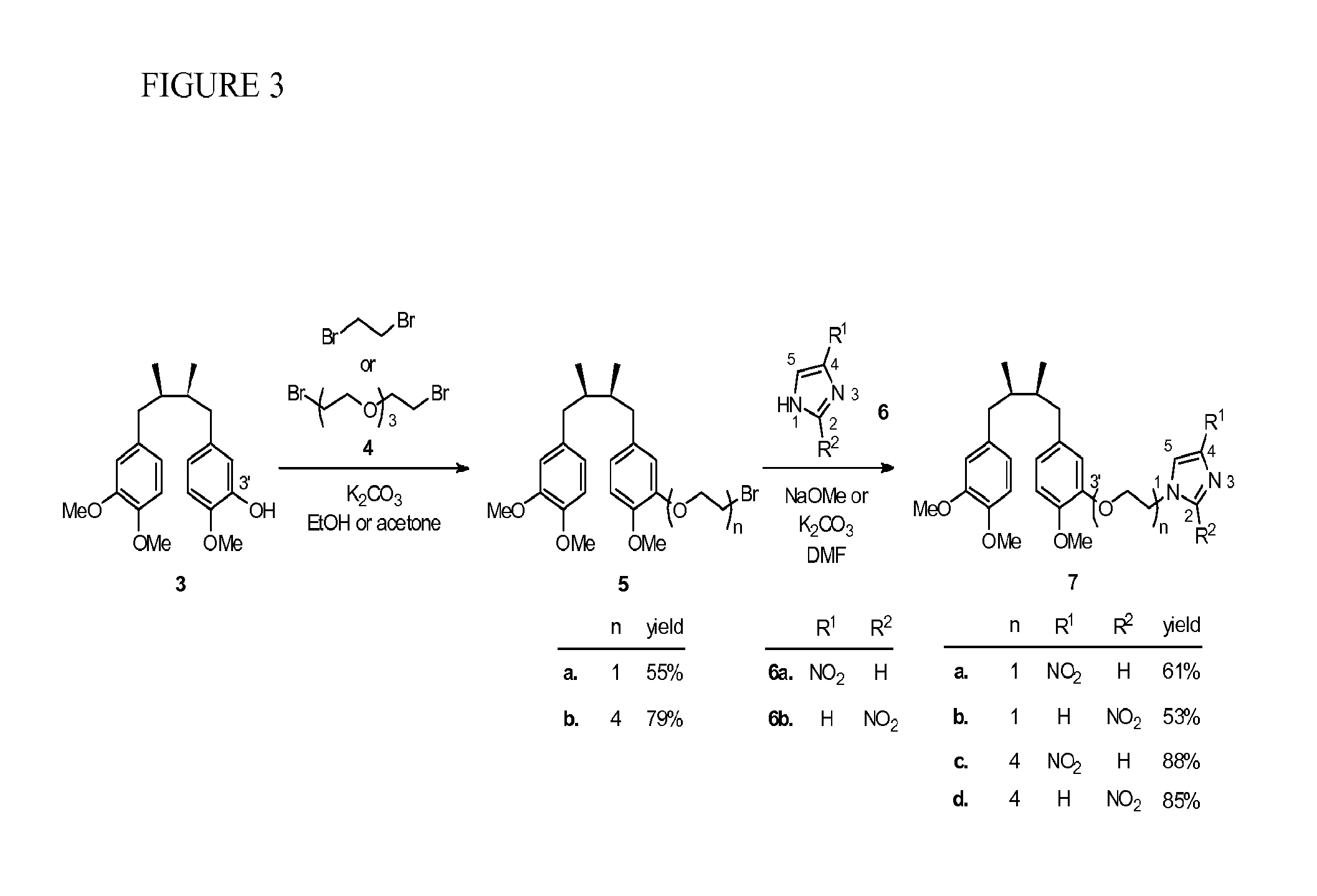Conjugates of nitroimidazoles and their use as chemotherapeutic agents
a technology of nitroimidazoles and chemotherapeutic agents, which is applied in the field of conjugates of nitroimidazoles and their use as chemotherapeutic agents, can solve the problems of shortage of blood perfusion and oxygen delivery in the liver, poor treatment effect of hcc, and inability to achieve the effect of improving water solubility and improving the effect of tetra-o-methyl ndga
- Summary
- Abstract
- Description
- Claims
- Application Information
AI Technical Summary
Benefits of technology
Problems solved by technology
Method used
Image
Examples
example 1
[0082]Using the method of Hwu et al. (J. Med. Chem. 1998, 41, 2994-3000), two isomeric trimethyl NDGA (±)-3 and (±)-8 were obtained in pure form as the starting materials for the syntheses of the conjugates 7 and 10 (see Scheme 1, FIG. 2). Treatment of 3 with 1,2-dibromoethane in the presence of potassium carbonate gave the corresponding NDGA bromide 5a. Regioisomeric 4- and 2-nitroimidazoles 6a and 6b are commercially available and were used respectively to couple with 5a under alkaline conditions. The desired NDGA-nitroimidazoles (±)-7a and (±)-7b were obtained in 61% and 53% yields, respectively. Given the same synthetic procedure by using bis[2-(2-bromoethoxy)ethyl]ether (4) to replace 1,2-dibromoethane, we produced PEG-containing conjugates 7c and 7d in higher yields (85-88%).
[0083]After the nitroimidazole moieties were tethered to the 3′-position of NDGA in conjugates 7a-d, the corresponding regioisomeric 4′-analogs were also obtained. Syntheses were started with the trimethyl...
example 2
[0088]Standard Procedure 1 for the Preparation of NDGA Bromides 5a,b, and 9a,b. To a solution containing a trimethyl NDGA (3 or 8) in ethanol or acetone was added potassium carbonate and an organic bromide (1,2-dibromoethane or 4). After the solution was heated at reflux overnight, the reaction mixture was cooled to room temperature. It was quenched with water (10.0 mL) and extracted with EtOAc (5×10.0 mL). The combined organic layers were washed with saturated aqueous NaCl (5.0 mL), dried over MgSO4(s), filtered, and concentrated under reduced pressure. The residue was purified by use of column chromatography to give the desired NDGA bromide. Purity of products 5a,b, and 9a,b was >98.5%, as checked by HPLC.
example 3
[0089]Synthesis of (±)-(2R,3S)-1-[3-(2-Bromoethoxy)-4-methoxyphenyl]-4-(3,4-dimethoxyphenyl)-2,3-dimethylbutane (5a). The Standard Procedure 1 was followed by use of 3 (86.4 mg, 0.251 mmol, 1.0 equiv), potassium carbonate (69.4 mg, 0.502 mmol, 2.0 equiv), and 1,2-dibromoethane (944.0 mg, 5.025 mmol, 20 equiv) in ethanol (10.0 mL). After workup and purification with column chromatography (25% EtOAc in hexanes as eluant), 5a (61.7 mg, 0.137 mmol) was obtained in 55% yield as white solids: mp (recrystallized from dichoromethane) 79.0-79.5° C.; 1H NMR (CDCl3, 400 MHz) δ 0.82 (d, J=6.8 Hz, 3H, CH3), 0.83 (d, J=6.4 Hz, 3H, CH3), 1.72-1.75 (m, 2H, 2×CH), 2.23-2.31 (m, 2H, 2×ArCH), 2.70-2.74 (m, 2H, 2×ArCH), 3.63 (t, J=7.0 Hz, 2H, CH2Br), 3.82 (s, 3H, OCH3), 3.83 (s, 3H, OCH3), 3.84 (s, 3H, OCH3), 4.28 (t, J=6.8 Hz, 2H, CH2O), 6.63-6.68 (m, 3H, 3×ArH), 6.72-6.80 (m, 3H, 3×ArH); 13C NMR (CDCl3, 100 MHz) δ 16.16, 16.19, 29.06, 38.57, 38.84, 39.14, 39.20, 55.77, 55.87, 56.07, 69.26, 110.95, 11...
PUM
| Property | Measurement | Unit |
|---|---|---|
| humidity | aaaaa | aaaaa |
| humidity | aaaaa | aaaaa |
| temperature | aaaaa | aaaaa |
Abstract
Description
Claims
Application Information
 Login to View More
Login to View More - R&D
- Intellectual Property
- Life Sciences
- Materials
- Tech Scout
- Unparalleled Data Quality
- Higher Quality Content
- 60% Fewer Hallucinations
Browse by: Latest US Patents, China's latest patents, Technical Efficacy Thesaurus, Application Domain, Technology Topic, Popular Technical Reports.
© 2025 PatSnap. All rights reserved.Legal|Privacy policy|Modern Slavery Act Transparency Statement|Sitemap|About US| Contact US: help@patsnap.com



